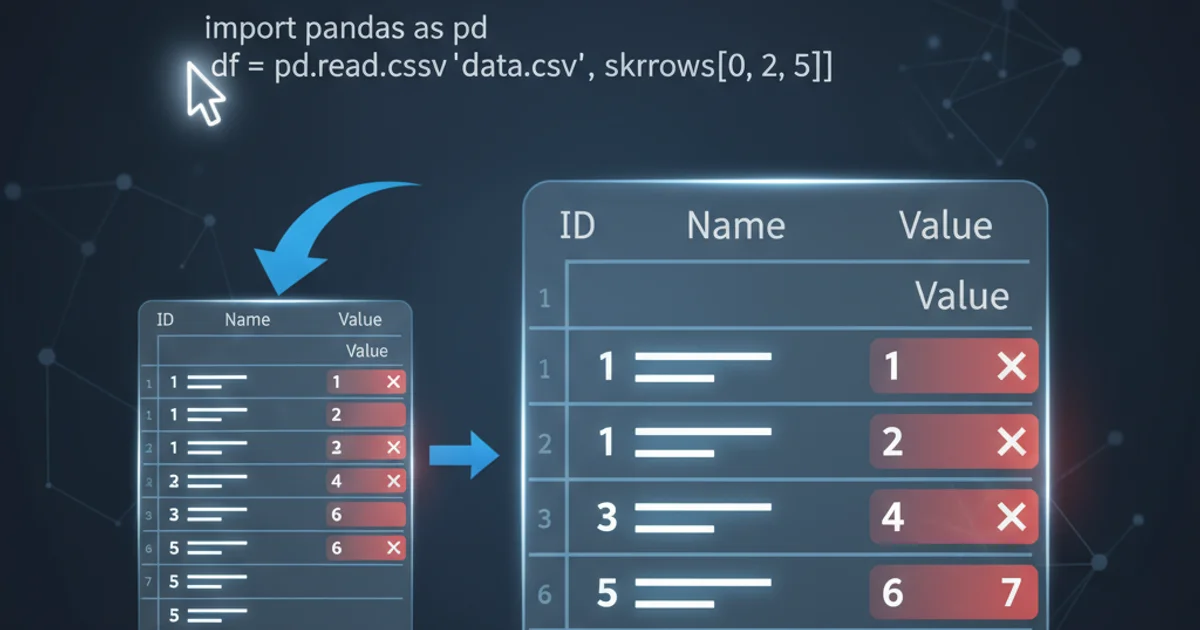Skip rows during csv import pandas
Categories:
Efficiently Skipping Rows During CSV Import with Pandas

Learn how to effectively skip header rows, footer rows, or specific data rows when importing CSV files into Pandas DataFrames, ensuring clean and accurate data loading.
When working with real-world datasets, CSV files often come with extra information that isn't part of the actual data you want to analyze. This can include metadata at the beginning or end of the file, comments, or simply blank rows. Pandas, a powerful data manipulation library in Python, provides several flexible options to handle these scenarios, allowing you to skip unwanted rows during the import process. This article will guide you through various methods to achieve this, ensuring your DataFrame contains only the relevant data.
Skipping Header and Footer Rows
One of the most common requirements is to skip a certain number of rows from the beginning (header) or end (footer) of a CSV file. Pandas' read_csv function offers dedicated parameters for this. The skiprows parameter is used to skip rows from the start, and skipfooter (with the engine='python' parameter) is used for skipping rows from the end. It's important to note that skipfooter requires the Python engine because the default C engine cannot seek backwards from the end of the file.
import pandas as pd
import io
# Sample CSV content with extra header/footer
csv_data = """
# This is a comment line
Metadata: Project Alpha
Date: 2023-10-26
ID,Name,Value
1,Apple,100
2,Banana,150
3,Orange,120
# End of data
"""
# Skip the first 3 rows (comments/metadata)
df_skip_header = pd.read_csv(io.StringIO(csv_data), skiprows=3)
print("DataFrame after skipping 3 header rows:\n", df_skip_header)
# Skip the last 1 row (footer comment)
df_skip_footer = pd.read_csv(io.StringIO(csv_data), skiprows=3, skipfooter=1, engine='python')
print("\nDataFrame after skipping 3 header and 1 footer row:\n", df_skip_footer)
Example of skipping header and footer rows using skiprows and skipfooter.
skipfooter, remember to explicitly set engine='python'. This might be slightly slower for very large files compared to the default C engine, but it's necessary for this functionality.Skipping Specific Rows by Index or Condition
Sometimes, the rows to be skipped are not just at the beginning or end, but scattered throughout the file, or they might need to be identified by a specific condition. The skiprows parameter can also accept a list of integers representing the 0-indexed row numbers to skip. For more complex conditional skipping, you can read the entire file and then filter, or use a custom function with skiprows.
import pandas as pd
import io
# Sample CSV content with specific rows to skip
csv_data_specific = """
Header1,Header2,Header3
1,DataA,10
# This is a row to skip
2,DataB,20
3,DataC,30
# Another row to skip
4,DataD,40
"""
# Skip rows by index (e.g., 2nd and 5th row, 0-indexed)
df_skip_indices = pd.read_csv(io.StringIO(csv_data_specific), skiprows=[2, 5])
print("DataFrame after skipping specific rows by index:\n", df_skip_indices)
# Skipping rows based on a condition (e.g., rows starting with '#')
def skip_comments(line):
return line.startswith('#')
df_skip_conditional = pd.read_csv(io.StringIO(csv_data_specific), skiprows=skip_comments)
print("\nDataFrame after skipping rows conditionally:\n", df_skip_conditional)
Demonstrates skipping rows by providing a list of indices or a callable function to skiprows.
flowchart TD
A[Start CSV Import] --> B{Identify Skip Strategy}
B --"Skip N header rows"--> C[Use skiprows=N]
B --"Skip N footer rows"--> D[Use skipfooter=N, engine='python']
B --"Skip specific rows by index"--> E[Use skiprows=[idx1, idx2, ...]]
B --"Skip rows based on content"--> F[Use skiprows=callable_function]
C --> G[Load Data]
D --> G
E --> G
F --> G
G --> H[Clean DataFrame]Decision flow for choosing the appropriate skiprows strategy in Pandas.
Handling Mixed Data Types and Delimiters
While not directly related to skipping rows, it's common to encounter issues with mixed data types or incorrect delimiters in CSV files that can affect how skiprows behaves or how the data is parsed after skipping. Always ensure your delimiter is correctly identified and consider using dtype parameter to explicitly define column types if Pandas infers them incorrectly after skipping rows.
skiprows with header=None or header=integer. If you skip rows that contain the actual header, Pandas might incorrectly assign the first data row as the header, or assign default integer column names.By mastering these read_csv parameters, you can significantly streamline your data cleaning and preparation workflow, making your Pandas scripts more robust and adaptable to various CSV file formats.